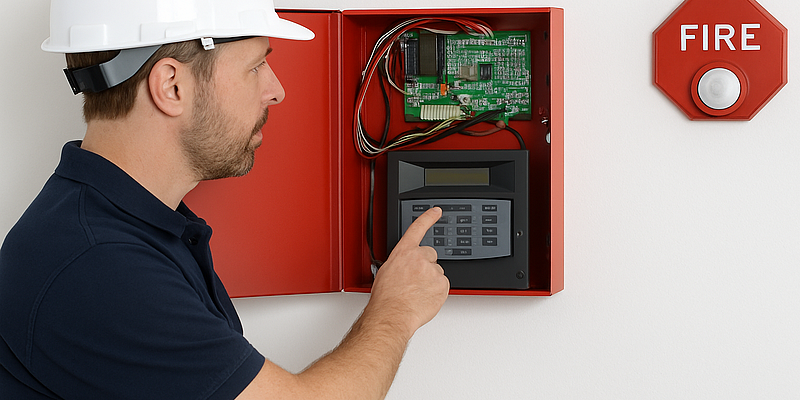-
24 Hour Emergency Service
- 24 Hour Emergency Service
Mastering Fire Alarm Placement: Essential Guidelines for Compliance and Safety
Welcome to the ultimate guide on fire alarm system placement and compliance! In this post, we’ll delve into the NFPA 72 standards, breaking down the essentials of detector placement, notification appliances, and documentation requirements. Whether you’re a fire alarm installer or simply looking to enhance your knowledge, this guide will ensure you avoid common mistakes, pass inspections, and keep buildings safe from fire hazards. Let’s dive in!
Understanding NFPA 72: The Cornerstone of Fire Alarm Systems
NFPA 72 is the National Fire Alarm and Signaling Code, the definitive source for fire alarm system standards. It covers everything from detector placement to notification appliances, ensuring fire alarm systems are safe, reliable, and compliant.
Three key chapters from NFPA 72 are crucial for fire alarm installers:
- Chapter 10: Focuses on system design and documentation requirements—your blueprint for compliance.
- Chapter 17: Defines the placement and installation of initiating devices such as smoke detectors, heat detectors, and manual pull stations.
- Chapter 18: Governs notification appliances like horns, strobes, and speaker strobes, specifying height and spacing requirements.
- Chapter 10: The Fundamentals of Fire Alarm Design
- Chapter 10 sets the baseline requirements for all fire alarm systems. This section outlines who is responsible for compliance, how systems should perform, and the lifecycle expectations for fire alarm systems.
Key takeaways from Chapter 10:
System Installer Responsibilities: Fire alarm equipment must be listed for fire alarm use and installed per approved plans, manufacturer specifications, and Authority Having Jurisdiction (AHJ) requirements.
Documentation Essentials: Submittals must include riser diagrams, wiring diagrams, battery calculations, and device tags to ensure installation accuracy.
Power Supply Standards: Fire alarm systems must have primary and secondary power sources, with standby current lasting at least 24 hours.
Signal Priority: Alarm signals take precedence over trouble signals, ensuring life safety warnings are always prioritized.
Chapter 17: Placement and Functionality of Initiating Devices
Initiating devices are the first line of defense in fire detection, capable of detecting environmental changes and signaling the fire alarm control panel. Chapter 17 provides detailed guidelines for smoke detectors, heat detectors, manual pull stations, water flow detectors, and more.
Key placement rules to remember:
Smoke Detectors: Keep them 3 feet away from air diffusers or vents. Wall-mounted units should be 4-6 inches down from the ceiling, while ceiling-mounted detectors must be 4 inches to 1 foot away from the wall.
Heat Detectors: Spacing is 50 feet, compared to 30 feet for smoke detectors. Ideal for areas prone to false alarms such as kitchens and garages.
Manual Pull Stations: Install within 5 feet of exit doors, at a height of 48-54 inches above the floor. Larger entry doors may require pull stations on both sides.
Chapter 18: Notification Appliances and Alerts
Notification appliances such as horns, strobes, and speakers are crucial for alerting occupants during emergencies. Chapter 18 outlines the requirements for their selection, placement, and synchronization.
Here’s what you need to know:
Sound Pressure Requirements: Audible appliances must produce at least 15 decibels above the ambient sound level and a minimum of 75 decibels at pillow level.
Visible Notification Appliances: Strobes must have a specific candela intensity tailored to the room size and ceiling height, ranging from 15 to 110 candela.
Synchronization: All strobes in the same field of view must flash in unison to prevent confusion or health risks.
Sleeping Areas: Use high-intensity horn strobes with 110 candela minimum and low-frequency sound at 520 Hz for dorms, assisted living facilities, and apartments.
Actionable Tips for Fire Alarm Installers
To ensure a compliant and effective fire alarm system, take note of these actionable tips:
Take the License Navigator Course to navigate NFPA 72 codes with ease.
Prepare detailed shop drawings, including riser diagrams, wiring diagrams, and battery calculations.
Use laser distance meters for accurate spacing measurements don’t rely on estimates!
Ensure all components are compatible with each other and comply with the manufacturer's specifications.
Maintain thorough documentation and communicate any impairments to the building owner promptly.
Conclusion: Achieving Fire Safety Excellence
Understanding and following NFPA 72 ensures the reliability and effectiveness of fire alarm systems, protecting lives and property during emergencies. By mastering fire alarm placement, documentation, and compliance, you can deliver systems that meet the highest safety standards.
Ready to take your fire alarm installations to the next level? Download our tools and resources to navigate NFPA codes like a pro. Share your thoughts and experiences in the comments below! Follow us on social media for more tips and updates. Your safety is our priority let’s build a safer future together.
‹ Back













Comments